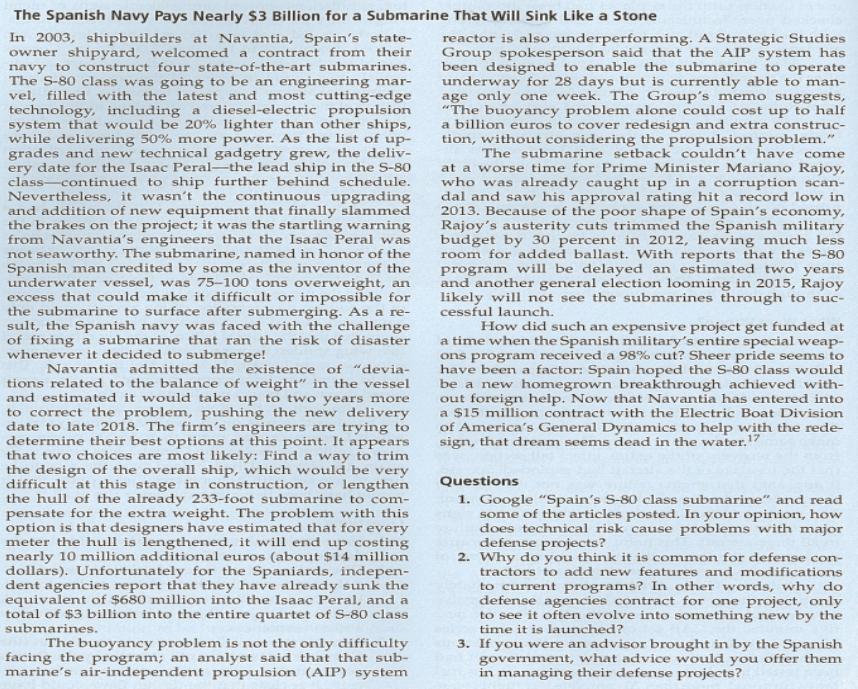Answered step by step
Verified Expert Solution
Question
1 Approved Answer
The Spanish Navy Pays Nearly $3 Billion for a Submarine That Will Sink Like a Stone In 2003, shipbuilders at Navantia, Spain's state- owner

The Spanish Navy Pays Nearly $3 Billion for a Submarine That Will Sink Like a Stone In 2003, shipbuilders at Navantia, Spain's state- owner shipyard, welcomed a contract from their navy to construct four state-of-the-art submarines. The S-80 class was going to be an engineering mar- vel, filled with the latest and most cutting-edge technology, including a diesel-electric propulsion system that would be 20% lighter than other ships, while delivering 50% more power. As the list of up- grades and new technical gadgetry grew, the deliv- ery date for the Isaac Peral-the lead ship in the S-80 class-continued to ship further behind schedule. Nevertheless, it wasn't the continuous upgrading and addition of new equipment that finally slammed the brakes on the project; it was the startling warning from Navantia's engineers that the Isaac Peral was not seaworthy. The submarine, named in honor of the Spanish man credited by some as the inventor of the underwater vessel, was 75-100 tons overweight, an excess that could make it difficult or impossible for the submarine to surface after submerging. As a re- sult, the Spanish navy was faced with the challenge of fixing a submarine that ran the risk of disaster whenever it decided to submerge! Navantia admitted the existence of "devia- tions related to the balance of weight" in the vessel and estimated it would take up to two years more to correct the problem, pushing the new delivery date to late 2018. The firm's engineers are trying to determine their best options at this point. It appears that two choices are most likely: Find a way to trim the design of the overall ship, which would be very difficult at this stage in construction, or lengthen the hull of the already 233-foot submarine to com- pensate for the extra weight. The problem with this option is that designers have estimated that for every meter the hull is lengthened, it will end up costing nearly 10 million additional euros (about $14 million dollars). Unfortunately for the Spaniards, indepen- dent agencies report that they have already sunk the equivalent of $680 million into the Isaac Peral, and a total of $3 billion into the entire quartet of S-80 class submarines. reactor is also underperforming. A Strategic Studies Group spokesperson said that the AlIP system has been designed to enable the submarine to operate underway for 28 days but is currently able to man- age only one week. The Group's memo suggests, "The buoyancy problem alone could cost up to half a billion euros to cover redesign and extra construc- tion, without considering the propulsion problem." The submarine setback couldn't have come at a worse time for Prime Minister Mariano Rajoy, who was already caught up in a corruption scan- dal and saw his approval rating hit a record low in 2013. Because of the poor shape of Spain's economy, Rajoy's austerity cuts trimmed the Spanish military budget by 30 percent in 2012, leaving much less room for added ballast. With reports that the S-80 program will be delayed an estimated two years and another general election looming in 2015, Rajoy likely will not see the submarines through to suc- cessful launch. How did such an expensive project get funded at a time when the Spanish military's entire special weap- ons program received a 98% cut? Sheer pride seems to have been a factor: Spain hoped the S-80 class would be a new homegrown breakthrough achieved with- out foreign help. Now that Navantia has entered into a $15 million contract with the Electric Boat Division of America's General Dynamics to help with the rede- sign, that dream seems dead in the water.17 Questions 1. Google "Spain's S-80 class submarine" and read some of the articles posted. In your opinion, how does technical risk cause problems with major defense projects? 2. Why do you think it is common for defense con- tractors to add new features and modifications to current programs? In other words, why do defense agencies contract for one project, only to see it often evolve into something new by the time it is launched? 3. If you were an advisor brought in by the Spanish government, what advice would you offer them in managing their defense projects? The buoyancy problem is not the only difficulty facing the program; an analyst said that that sub- marine's air-independent propulsion (AIP) system
Step by Step Solution
There are 3 Steps involved in it
Step: 1
1 The technical risks associated with major defense projects are that the defense projects are always evolved with a theoretical assumption which when ...
Get Instant Access to Expert-Tailored Solutions
See step-by-step solutions with expert insights and AI powered tools for academic success
Step: 2

Step: 3

Ace Your Homework with AI
Get the answers you need in no time with our AI-driven, step-by-step assistance
Get Started


